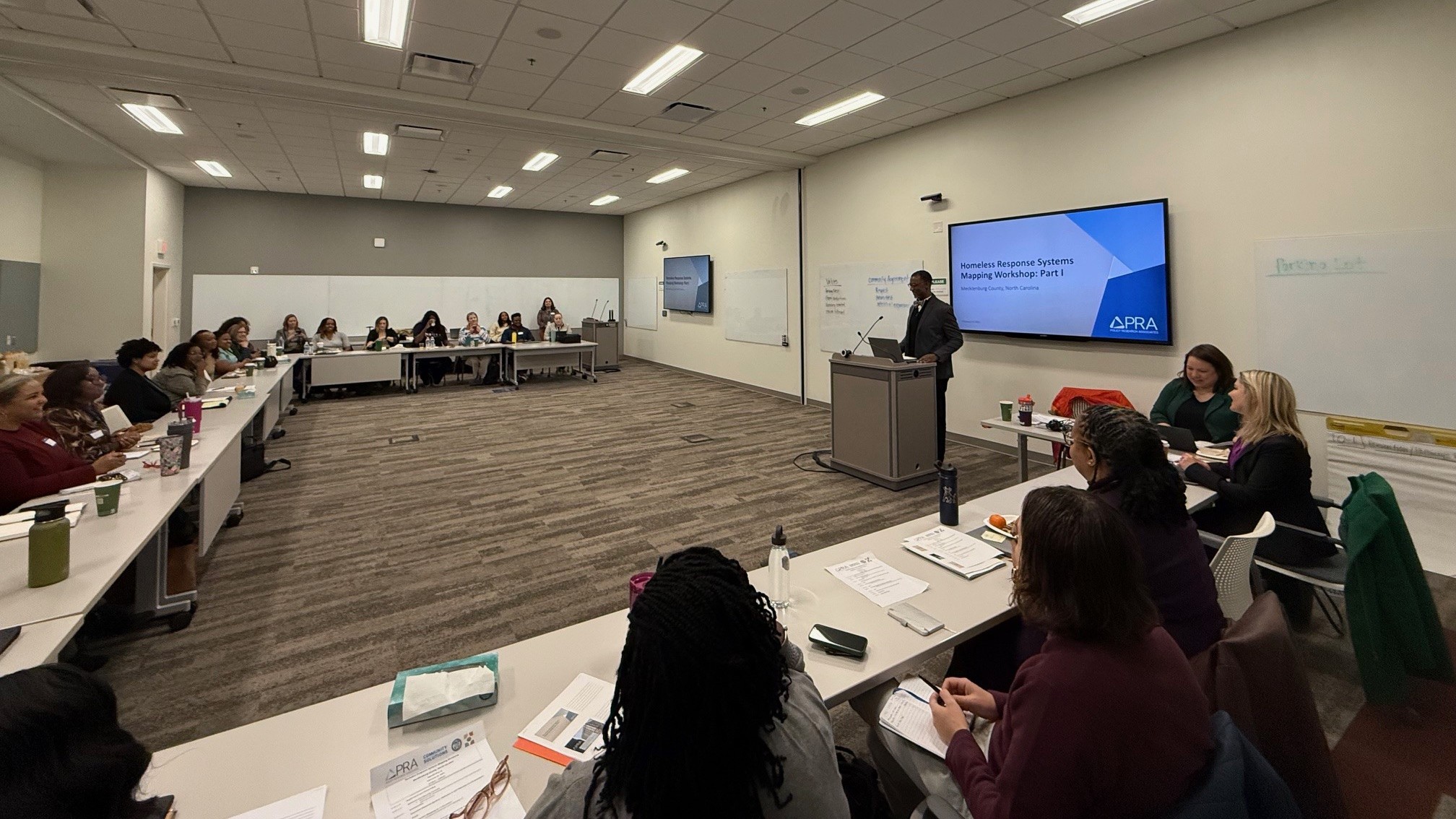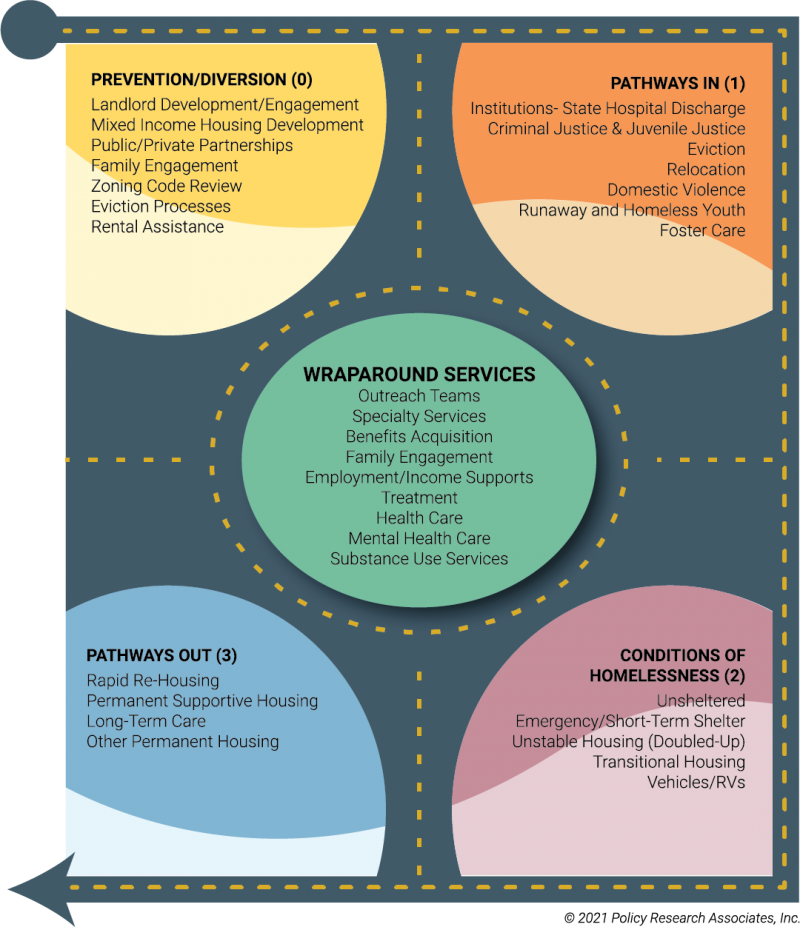In 2024, over 770,000 people in the United States experienced homelessness on a single night (U.S. Department of Housing and Urban Development, 2024). Unfortunately, related services networks do not have enough resources to help all people experiencing or at risk of homelessness.
Some health issues are more common among people experiencing homelessness. They include the following:
- Mental and substance use disorders, which are found disproportionately more often in LGBTQ+ and Black youth (Fraser et al., 2019; Narendorf, 2017)
- Trauma, adverse childhood experiences, and victimization (Phipps et al., 2019; Kim et al., 2018).
Our Solution
The Homeless Response Systems Mapping is a targeted mapping event. It focuses on identifying and developing community-based responses to homelessness. The mapping does this by planning around critical intersections. The right supports and services at the right time can help prevent homelessness or connect people experiencing homelessness with stable, safe housing. Innovations requiring interdisciplinary and cross-sector collaboration are needed to end homelessness, including coordination from policymakers, governmental agencies, social services agencies, the healthcare industry, and researchers, are needed to end homelessness (Elder & King, 2018). Working together allows them to reach essential goals, including the following:
- Stabilizing housing for those at risk of homelessness
- Connecting individuals and families experiencing homelessness with services
- Helping people move from using homeless services to living in appropriate and safe permanent housing.
The Homeless Response Systems Mapping helps participants make a plan aimed at achieving these goals.
Our Model
The Homeless Response Systems Mapping was developed by Policy Research. Its purpose is to help people think concretely about how individuals experience homelessness and move to recovery. The model allows communities to see how individuals interact with homeless services and highlights paths to safe, permanent housing.
As part of a cross-systems mapping event, facilitators will:
- Conduct research and collect data from the community to identify who is experiencing homelessness and why;
- Interview key collaborators who work with and know the network, from individuals providing services to the people in charge;
- Create a map of the four points of intersection that defines existing resources and gaps; and
- Integrate a discussion of solutions for the identified gaps and needs.
The Homeless Systems Map model highlights four points of intersection. They are prevention/diversion, pathways in, conditions of homelessness, and pathways out. In addition, a variety of wraparound services intersect with each point.
- Prevention/Diversion: Prevention and diversion programs aim to stop homelessness before it happens. They identify and help people and families before they start using homeless services. Programs at this intersection also offer alternatives to mainstream homeless services. Overall, they work to prevent individuals and families from losing housing.
- Pathways In: Individuals and families enter the homeless service system due to a wide range of circumstances. Common reasons include job loss, unexpected medical bills, and a mental health crisis. Other common reasons are family separation and exiting the foster-care system.
- Conditions of Homelessness: There is no one way to define homelessness. Definitions vary among federal agencies, funding sources, and age groups. Whether or not people and families qualify for services often depends on whether they fit the provider’s definition. This makes it very important to know which definition service providers use. When you know who qualifies, it helps provide a smoother transition of care between agencies and services.
- Pathways Out: The pathways out of homelessness are as diverse as the pathways into homelessness. To understand how this works in your area, it is key to collect information about outcomes. Specific metrics help show how local homeless service networks are doing. One metric many communities track is the length of time people spend experiencing homelessness. Others are the number of exits to permanent housing and return to homelessness.
- Wraparound Services: Services are key to ongoing housing stability for many individuals and families. Wraparound services provide help at every stage, from the earliest prevention work to pathways out of homelessness.
Participants
The participants involved in the Homeless Response Systems Mapping may include the following:
- Behavioral health and physical health services, including clinicians, caseworkers, peer specialists, physicians, and psychologists
- Education professionals, including school administrators, school psychologists, social workers, and homeless liaisons
- Employment services professionals, including employment specialists and benefit planners
- Homelessness services professionals, including outreach workers and people who have lived experience of homelessness
- Housing providers, including housing authorities, affordable housing developers, and permanent supportive housing operators
- Peers and family advocates
- Funders, such as grantmakers and program developers
- Legal services professionals, including pro bono attorneys
- Social services professionals such as program directors and caseworkers
- Representatives from populations of interest, as determined by the community (e.g., people who are in contact with the criminal legal system, Native communities, transition-age youth)
Impact in the Field
In 2025, the Systems Mapping and Training Center worked with Mecklenburg County, North Carolina, to identify and develop community-based responses to homelessness. Housing, homeless services, and behavioral health system partners, led by the Charlotte-Mecklenburg Continuum of Care, examined city, county, and state-level resources, gaps in services, and opportunities for cross-system collaboration and partnership across the four points of intersection. Over the course of the 1.5-day event, the group reviewed the data around their current homeless response system, learned about the Pathways In and Pathways Out of the Homeless Responses System intersections, participated in a facilitated discussion of their resources, gaps, and opportunities, and then voted on strategic priorities for change. The group then developed a detailed action plan around three priority areas of work (flexible funding for eviction prevention, strengthening a whole-person model of care, and improving agency partnerships to enhance “Moving On” strategies) to further the community’s goals of preventing homelessness.
Participants of the Mecklenburg Homeless Response System Mapping shared:
- “It was a well-facilitated event that helped us leave with action items, which I believe are what providers are craving right now.”
- “The facilitation and consulting from PRA was top-notch! Really well done, thank you!”
- “It was a great event to be a part of, and hope a lot of positive outcomes result from it.”
Community partners will implement an action plan developed around their strategic priorities, have access to a detailed resource map of their Homeless Response System, and a final report that details the community’s resources, gaps, and recommendations.
Follow-Up Assistance
Follow-up technical help is not always needed after participating in this systems mapping event. However, some jurisdictions find additional assistance useful. Further assistance could include developing a list of priorities based on identified gaps or creating an action plan to implement top priorities. If your community wants more support, the Systems Mapping and Training Center is here. The Center can host follow-up meetings, including facilitated strategic planning sessions, give guidance and resources, or connect you with topic experts. These follow-up opportunities are offered on a fee-for-service basis if the need comes up.
References
Fraser, B., Pierse, N., Chisholm, E., & Cook, H. (2019). LGBTIQ+ homelessness: A review of the literature. International Journal of Environmental Research and Public Health, 16(15), 2677. https://doi.org/10.3390/ijerph16152677
Kim, Y., Bender, K., Ferguson, K. M., Begun, S., & DiNitto, D. M. (2018). Trauma and posttraumatic stress disorder among homeless young adults: The importance of victimization experiences in childhood and once homeless. Journal of Emotional and Behavioral Disorders, 26(3), 131–142. https://doi.org/10.1177/1063426617710239
Narendorf, S. C. (2017). Intersection of homelessness and mental health: A mixed methods study of young adults who accessed psychiatric emergency services. Children and Youth Services Review, 81, 54–62. https://doi.org/10.1016/j.childyouth.2017.07.024
Phipps, M., Dalton, L., Maxwell, H., & Cleary, M. (2019). Women and homelessness, a complex multidimensional issue: Findings from a scoping review. Journal of Social Distress and the Homeless, 28(1), 1–13. https://doi.org/10.1080/10530789.2018.1534427
U.S. Department of Housing and Urban Development. (2024). The 2024 annual homelessness assessment report (AHAR) to Congress. https://www.huduser.gov/portal/sites/default/files/pdf/2024-AHAR-Part-1.pdf




